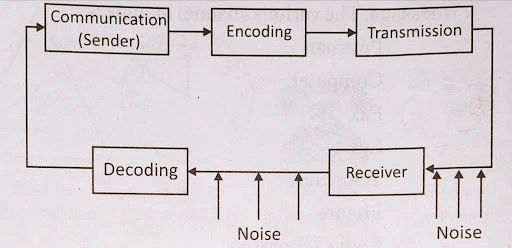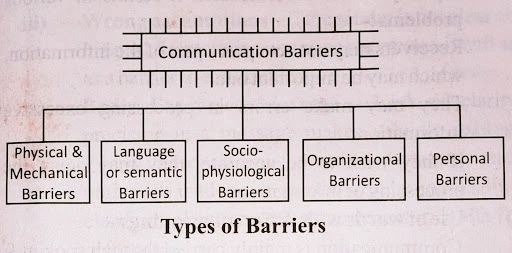Noise is the disruption or interference in conversation method anywhere. It can occur at any point inside the communique techniques.
- Noise can be the sound of some coughing, a truck driving by the way, or people speak me near at hand.
- It additionally encompasses disruptions consisting of the letter being lost within the mail, a phone line going lifeless or one of the participants in a verbal exchange being known as away before the verbal communication system is finished.

Noise may additionally rise because:-
- A manager is only sometimes capable of explicit himself properly.
- The attention of the listener is sometimes on the message.
- Memos could be better reproduced or written and therefore need to be examined.
Top 5 Type of Barriers in Communication
Different barriers to communication may be grouped as follows:-
- Physical & Mechanical Barriers
- Language or semantic obstacles
- Socio-Psychological Barriers
- Organisational Barriers
- Personal Barrier

1. Physical and Mechanical Barriers
The physical & Mechanical barriers can result from noise, distance, time & data overload.
i) Noise
Noise is the first & for maximum – enemy of communique. Any noise in the mode of conversation may destroy the discussion. It is one of the type of barriers in communication process. Distractions like past historical sounds, terrible lights or an environment that is too hot or bloodless can all affect human beings’ morale & concentration, which in turn intervene with effective conversation.
ii) Distance
Long distances between the senders & receivers also can abstract effective communique.
iii) Time
Time refers to the achievement of the message. If a critical message reaches past due, it will affect communication.
iv) Information overload
It refers to the immoderate transmission of information. If the transmitted information is beyond the mental capacity of the receiver, then it consequences in various troubles:-
- Receivers may not act upon a part of the data, which can be crucial.
- They may additionally make errors in processing immoderate statistics.
- If they want to be correct, they will delay information processing.
v) Use of words with different meanings
Communication is especially carried through spoken & written phrases. But the words used may also have distinct meanings for different people. For example, “tube” may imply a fluorescent, cycle, or water tube. It is one of the type of barriers in communication process.
When the sender or listener assigns a special meaning to a word than the writer or speaker supposed, miscommunication occurs.
vi) Poor or outdated equipment
Poor or outdated equipment may also produce excessive more leading to physical barriers in conversation.
2. Language & Semantic Barriers or Linguistic Barriers
Language is the carrier of all records & ideas. Semantic is the observation of that means & phrases. Semantic boundaries are those barriers which are associated with language. They encompass:-
The wrong desire of words:
The wrong desire for words results in an incorrect interpretation of the message.
i) Faulty Translation
For e.g., If the message acquired from France is transmitted into English & if the translation is executed carelessly, the message could be lost.
ii) Wrong assumptions
If the sender isn’t always clear approximately his purpose & entertains incorrect assumptions, it will function as a communication barrier. It is one of the type of barriers in communication process.
iii) Badly Expressed Message
Lack of clarity & precision in a message makes it badly expressed. Poorly selected & empty phrases and terms, careless omissions, insufficient vocabulary, jargon, and failure to make clear implications are a few common things that could be improved in this example.
iv) Specialist’s language
It is often discovered that technical personnel & unique corporations increase their specialized, particular & technical language. It is one of the type of barriers in communication process. This increases their isolation from others and builds a communication barrier.
3. Emotional & Psychological Barriers
Emotional & Psychological factors are the high limitations in interpersonal communication. Listening, interpretation or encoding & deciphering of a message relies upon the physical state of each transmitter & the receiver. Some of the emotional boundaries are described underneath:-
i) Differences in perception
Perceptual limitations can also stand up due to differences between individuals in the way they perceive, organize & apprehend their environment.
- Differences in belief arise from unique process reviews, instructional backgrounds, price gadgets & so on.
- Accordingly, someone receiving a message may interpret it in the light of his background. If there is openness in a relationship, the whole thing communicated can be conveniently believed. Not so, however, if there may be a mutual distrust or false impression between the sender and the receiver of the message.
ii) Negative Attitudes
Negative mindset also serves as a barrier to the communique. Due to a poor mindset, an ordinary message may be interpreted as an adverse message & the real meaning needs to be found.
iii) Emotional reactions
How the get hold of feels when receiving facts influences how he interprets the records effectively.
For e.g., If the receiver is in a cheerful mood, he translates the statistics in a unique & exciting manner. Extreme emotions or despair are likely to avert the effects of the conversation.
iv) In interest
The pre-occupied mind of a receiver & the ensuing non-listening is one of the fundamental persistent mental barriers. It is a common phenomenon that people need to react to bulletins, notices, mins & reviews.
- Distrust of the communicator arises due to ill-considered judgments or illogical selections & the manipulations of the authentic message with the aid of the communique. Repeated experience of this kind leads to putting off movement or acting unenthusiastically from the acquire aspect, which makes conversation unsuccessful.
- Premature Evaluation- Some people judge before receiving the entire message. Such untimely assessment prevents effective verbal exchange.
- Resistance to Change – It is the widespread tendency of humans to maintain the reputation quo. When new thoughts are communicated, the listening apparatus can also act as a filler in rejecting new ideas.
- Cultural Differences – Managers should regard cultural values and beliefs when dealing with employees from different international locations. They may need help to bring what they, in reality, wish to.
Symbols, phrases, shades, gestures, and language must be carefully decided on while senders of data deal with people of different nations or areas.
3. Organisational Barriers
The administrative hierarchy of a corporation can also create positive barriers to verbal exchange.
i) Rules & Regulations
Sometimes the sender is not satisfied with the rules & rules of the enterprise. So they will hesitate to send some messages & they choose to hold silent.
ii) Formal Division of Work
There are many classes of personnel based on their status & function. Sometimes the lower-degree worker can ship messages to the top man inside the organization without sending any notice to the top man. This legal department of work acts as a barrier to the communique. It is one of the type of barriers in communication process.
iii) Lack of Facilities
In a company, sufficient facilities like stationery, smartphone, translating facilities, fax, laptops, etc., must be available. These facilities need to be present in the communique.
iv) Attitude of the Management
If the attitude of the top-level officials is not responsive & high quality, then there cannot be the free drift of facts.
v) Excessive paintings
If the personnel are overburdened with excessive paintings, they have little time to interact freely. It serves as a barrier to conversation.
5. Personal Barriers
Some of the private barriers are mentioned below:
i) Attitude of Superiors
If the mindset of the superior is not favorable, there is an extra opportunity that messages could now not drift thoroughly from or to seniors. It is one of the type of barriers in communication process.
ii) Lack of confidence in subordinates
Some employees need more self-assurance and ability. In that case, they’re not able to advise superiors.
iii) Ignoring Communication
Sometimes superiors consciously & intentionally forget about the communique from their subordinates to maintain their significance. This works against the willingness of associates to communicate.
iv) Lack of time
Lack of time additionally acts as a barrier to verbal exchange.
v) Message overload
Message overload is certainly a hurdle inside the verbal exchange technique. Message overload prevents the orderly and smooth drift of facts.
vi) Barriers to subordinates
Subordinates are also similarly chargeable for proscribing communique drift in the upward route. They act as obstacles in some of the approaches:-
- They dislike showing mistakes.
- People generally withstand new thoughts.
- They suppress information referring to their screw-ups.
- Refrain from talking a message upward on private grounds.

